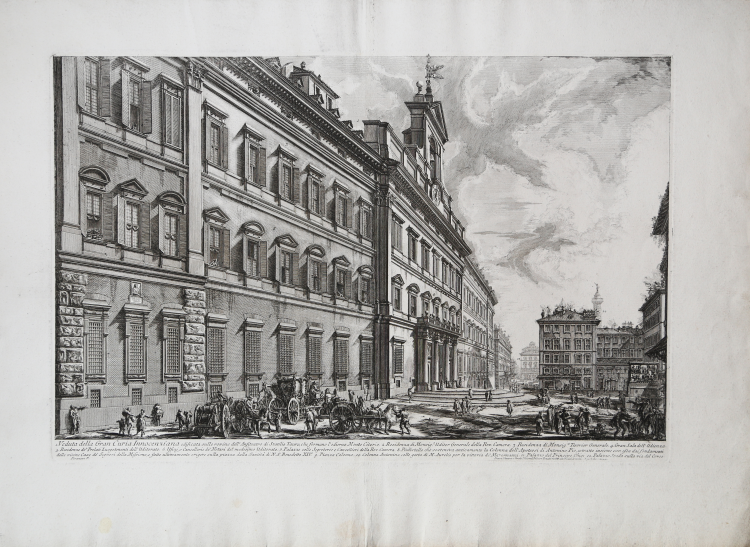




| Reference: | S46698 |
| Author | Giovan Battista PIRANESI |
| Year: | 1752 ca. |
| Zone: | Montecitorio |
| Printed: | Rome |
| Measures: | 620 x 407 mm |



| Reference: | S46698 |
| Author | Giovan Battista PIRANESI |
| Year: | 1752 ca. |
| Zone: | Montecitorio |
| Printed: | Rome |
| Measures: | 620 x 407 mm |
Etching and engraving, 1752, signed on plate.
Example from the contemporary Roman Edition, the first state of four, printed by Piranesi in his tipography of Strada Felice. A very good impression, printed on contemporary laid paper with watermark "double encircled fleur de lys with letters CB", with margins, good condition.
Taken from Vedute di Roma; the whole work consists of 135 plates which have been individually produced by Piranesi along 30 years, from 1745 circa until his death. Two more works have been subsequently added, two plates by his son Francesco. They have been printed for the first time in 1751 (34 plates) by the editor Giovanni Bouchard, afterwards by Piranesi himself, publisher in Palazzo Tomati in Rome (as it is written on m,any plates), until the final edition of 137 plates. After Piranesi's death, his son Francesco inherited the plates, editing them first in Rome and then in Paris. The Calcografia Camerale, nowadays Calcografia Nazionale, has then bought the plates which are now kept inside the building.
|
Hind n. 23, I/IV; Focillon 738.
|
Giovan Battista PIRANESI (Mogliano Veneto 1720 - Roma 1778)
|
Italian etcher, engraver, designer, architect, archaeologist and theorist. He is considered one of the supreme exponents of topographical engraving, but his lifelong preoccupation with architecture was fundamental to his art. Although few of his architectural designs were executed, he had a seminal influence on European Neo-classicism through personal contacts with architects, patrons and visiting artists in Rome over the course of nearly four decades. His prolific output of etched plates, which combined remarkable flights of imagination with a strongly practical understanding of ancient Roman technology, fostered a new and lasting perception of antiquity. He was also a designer of festival structures and stage sets, interior decoration and furniture, as well as a restorer of antiquities. The interaction of this rare combination of activities led him to highly original concepts of design, which were advocated in a body of influential theoretical writings. The ultimate legacy of his unique vision of Roman civilization was an imaginative interpretation and re-creation of the past, which inspired writers and poets as much as artists and designers.
|
|
Hind n. 23, I/IV; Focillon 738.
|
Giovan Battista PIRANESI (Mogliano Veneto 1720 - Roma 1778)
|
Italian etcher, engraver, designer, architect, archaeologist and theorist. He is considered one of the supreme exponents of topographical engraving, but his lifelong preoccupation with architecture was fundamental to his art. Although few of his architectural designs were executed, he had a seminal influence on European Neo-classicism through personal contacts with architects, patrons and visiting artists in Rome over the course of nearly four decades. His prolific output of etched plates, which combined remarkable flights of imagination with a strongly practical understanding of ancient Roman technology, fostered a new and lasting perception of antiquity. He was also a designer of festival structures and stage sets, interior decoration and furniture, as well as a restorer of antiquities. The interaction of this rare combination of activities led him to highly original concepts of design, which were advocated in a body of influential theoretical writings. The ultimate legacy of his unique vision of Roman civilization was an imaginative interpretation and re-creation of the past, which inspired writers and poets as much as artists and designers.
|